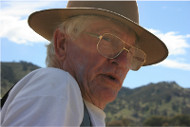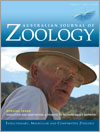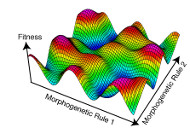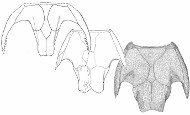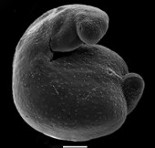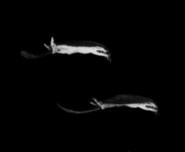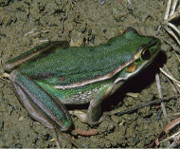Australian Journal of Zoology
Volume 62
Number 1 2014
Evolution and Adaptation: A Tribute to Richard Essex Barwick
This introduction presents various aspects of the life of Richard (Dick) Essex Barwick. Dick’s research included herpetology, functional anatomy, evolutionary biology and Arctic exploration, and sets the scene for the papers presented in this special issue that cover these various areas. Dick is remembered best for his ability to stimulate work by students and colleagues because of his enthusiasm and attitude to examining questions from various directions. This issue is dedicated to Dick’s legacy as indicated by the various papers contributed.
Photo courtesy of Laura Barwick.
Evolutionary change can be initiated by developmental innovation, for example by new genes, and by ecological change, for example by changing environments. A conceptual framework is developed for understanding the relative importance of developmental and ecological change in initiating morphological innovation. This approach leads to the identification of four primary modes of evolution, each of which has played a role in producing today’s biodiversity.
Dipnoans form a separate evolutionary lineage that began in the Early Devonian. Diabolepis and associated genera are not Dipnomorphs, but are isolated genera formed by gene regulation in the early Devonian.
Photo by Ken Campbell (Campbell & Barwick 2000).
Buchanosteid placoderms are a group of arthrodires (placoderm fishes) from the Early Devonian of Australia, China, Russia and Arabia. We redescribe Buchanosteus from new material and rediagnose Buchanosteidae, erect Parabuchanosteidae fam. nov., rediagnose Parabuchanosteus, and erect two new genera: Urvaspis gen. nov. from Russia and Richardosteus gen. nov. from New South Wales.
The fossil assemblage from the Aztec Siltstone of southern Victoria Land, discovered in 1911 during Scott’s British Antarctic Expedition, now contains 37 genera and 50 species of Devonian fishes – one of the most diverse fossil vertebrate assemblages from Antarctica, and of Middle-Late Devonian age anywhere in the world.
Many wild lungfish are now trapped in reservoirs, where water levels vary, and there are no refuges for eggs and young, and no sources of food. Potential recruitment of young lungfish in reservoirs faces another threat. Eggs and hatchlings are abnormal, and all the young in one season may die.
Photo by Anne Kemp.
When gliding, the feathertail glider (Acrobates pygmaeus) uses an ‘elbows flexed’ forelimb configuration, unlike the ‘elbows extended’ one seen in petaurid gliders. Nevertheless, its best (smallest) glide angles are comparable to those reported in sugar gliders; although, in accord with its lower aerofoil loading, the small glider uses lower air speeds.
Photo by Andrew Assauw.
One problem with documenting species declines is the absence of historical data. Here, we provide herpetofaunal data for Kioloa, coastal New South Wales, for the mid-1980s. We found 13 frog species and 11 reptile species. Strictly forest-dependent species were absent. The threatened Litoria aurea was widespread in the mid-1980s, but now survives only at one site.
Photo by Klaus Henle.
